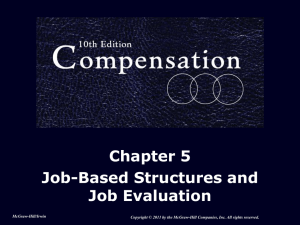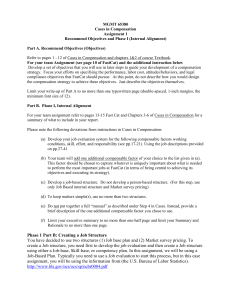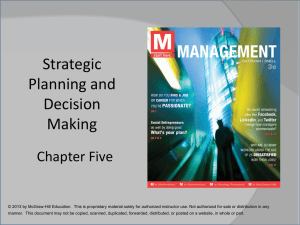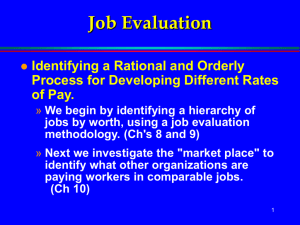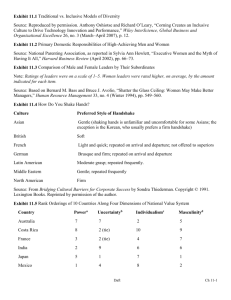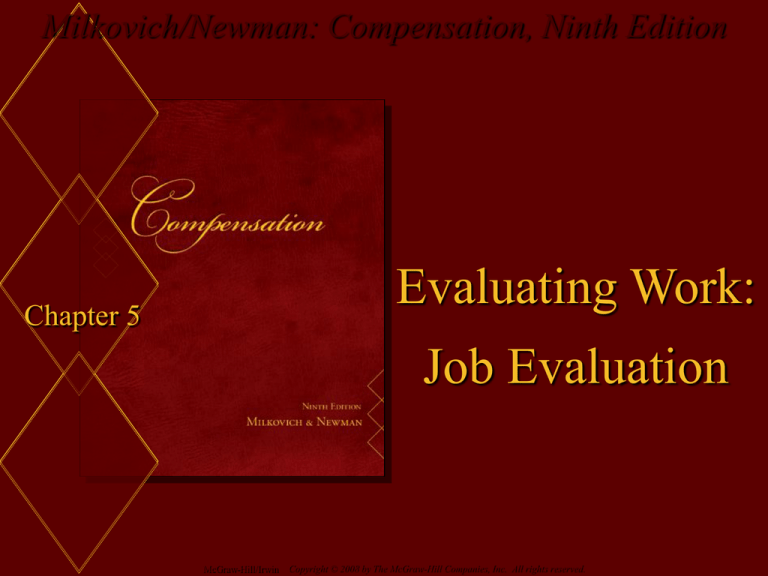
Milkovich/Newman: Compensation, Ninth Edition
Evaluating Work:
Chapter 5
Job Evaluation
McGraw-Hill/Irwin
Copyright © 2008 by The McGraw-Hill Companies, Inc. All rights reserved.
Chapter Topics
Job-Based Structures: Job Evaluation
Defining Job Evaluation: Content, Value, and
External Market Links
“How-to”: Major Decisions
Ranking
Classification
Point Method
5-2
Chapter Topics (cont.)
Who Should be Involved?
The Final Result: Structure
Balancing Chaos and Control
Your Turn: Job Evaluation at Whole Foods
5-3
Job-Based Structures: Job Evaluation
Job evaluation – process of systematically
determining the relative worth of jobs to create a
job structure for the organization
The evaluation is based on a combination of:
–
–
–
–
–
Job content
Skills required
Value to the organization
Organizational culture
External market
5-4
Exhibit 5.1: Many Ways to Create Internal Structure
5-5
Defining Job Evaluation: Content,
Value, and External Market Links
Content and value
– Exchange value
Linking content with the external market
– Value of job content is based on what it can
command in the external market
“Measure for measure” vs. “Much ado
about nothing”
5-6
Exhibit 5.2: Assumptions Underlying
Different Views of Job Evaluation
5-7
Defining Job Evaluation: Content, Value,
and External Market Links (cont.)
“How-To”: Major decisions
– Establish the purpose
Supports organization strategy
Supports work flow
Is fair to employees
Motivates behavior toward organization objectives
5-8
Exhibit 5.3: Determining an Internally
Aligned Job Structure
5-9
Defining Job Evaluation: Content, Value,
and External Market Links (cont.)
“How-To”: Major decisions (cont.)
– Single versus multiple plans
Characteristics of a benchmark job:
– Contents are well-known and relatively stable over time
– Job not unique to one employee
– A reasonable number of employees are involved in the job
Depth and breadth of job
Refer Exhibit 5.4
– Choose among methods
5-10
Exhibit 5.4: Benchmark Jobs
5-11
Exhibit 5.5: Comparison of Job
Evaluation Methods
5-12
Ranking
Orders
job descriptions from highest to lowest
based on a global definition of relative value or
contribution to the organization’s success
– Simple, fast, and easy to understand and explain
– Initially, the least expensive method
– Can be misleading
– Two approaches
Alternation ranking
Paired comparison method
5-13
Exhibit 5.6: Paired Comparison Ranking
5-14
Classification
Uses
class descriptions that serve as the
standard for comparing job descriptions
Classes
include benchmark jobs
Outcome: Series
of classes with a number of
jobs in each
5-15
Exhibit 5.7: Classifications for Engineering
Work Used by Clark Consulting
5-16
Point Method
Three
common characteristics of point
methods:
– Compensable factors
– Factor degrees numerically scaled
– Weights reflect relative
importance of each factor
Most
commonly used approach to establish pay
structures in U.S.
Differ from other methods by making explicit
the criteria for evaluating jobs – compensable
factors
5-17
Designing a Point Plan: Six Steps
Conduct job analysis
Determine compensable factors
Scale the factors
Weight the factors according to importance
Communicate the plan, train users; prepare
manual
Apply to nonbenchmark jobs
5-18
Step 1: Conduct Job Analysis
Point plans begin with job analysis
A representative sample of jobs (benchmark
jobs) is drawn for analysis
Content of these jobs is basis for:
– Defining compensable factors
– Scaling compensable factors
– Weighting compensable factors
5-19
Step 2: Determine Compensable Factors
Compensable factors – characteristics in the
work that the organization values, that help it
pursue its strategy and achieve its objectives
Compensable factors play a pivotal role
– Reflect how work adds value to organization
– Decision making is three-dimensional:
Risk and complexity
Impact of decision
Time that must pass before evidence of impact
5-20
Exhibit 5.9: Compensable Factor Definition: Decision Making
5-21
Step 2: Determine Compensable Factors
(cont.)
To be effective, compensable factors should be:
– Based on strategy and values of organization
– Based on work performed
Documentation is important
– Acceptable to the stakeholders
– Adapting factors from existing plans
Skills, and effort required; responsibility, and working
conditions
NEMA, NMTA, Equal Pay Act (1963), and Steel plan
5-22
Compensable Factors - How Many
Factors?
– “Illusion of validity” - Belief that factors are
capturing divergent aspects of a job and are
both important
– “Small numbers” - If even one job has a certain
characteristic, it must be a compensable factor
– “Accepted and doing the job” – 21 factor, 7
factors, 3 factors
– Research results
Skills explain 90% or more of variance
Three factors account for 98 - 99% of variance
5-23
Exhibit 5.10: Compensable Factor
Definition: Multinational Responsibilities
5-24
Exhibit 5.11: Factors in Hay Plan
5-25
Exhibit 5.12: Hay Guide Chart – Profile Method of Job
Evaluation
5-26
Step 3: Scale the Factors
Construct scales reflecting different degrees
within each factor
– Most factor scales consist of four to eight degrees
Issue
– Whether to make each degree equidistant from
adjacent degrees (interval scaling)
5-27
Step 3: Scale the Factors (cont.)
Criteria for scaling factors
Ensure
number of degrees is necessary to distinguish
among jobs
Use
understandable terminology
Anchor
degree definitions with benchmark-job titles
and/or work behaviors
Make
it apparent how degree applies to job
5-28
Exhibit 5.13: Factor Scaling – National Metal Trades
Association
5-29
Step 4: Weight the Factors According to
Importance
– Different weights reflect differences in
importance attached to each factor by the
employer
– Determination of factor weights
Advisory committee allocates 100 percent of the
value among factors
5-30
Step 4: Weight the Factors According to
Importance (cont.)
Select criterion pay structure
– Committee members recommend the criterion pay
structure
– Statistical approach is termed policy capturing to
differentiate it from the committee a priori judgment
approach
– Weights also influence pay structure
5-31
Exhibit 5.14: Job Evaluation Form
5-32
Overview of the Point System
Degree of Factor
Job Factor
Weight
1
2
3
4
5
1. Education
50%
100
200
300
400
500
2. Responsibility
30%
75
150
225
300
3. Physical
effort
12%
24
48
72
96
4. Working
conditions
8%
25
51
80
120
5-33
AAIM National Position Evaluation Plan
Points Assigned to Factor Degrees
Factor
1st
2nd
3rd
4th
5th
Degree Degree Degree Degree Degree
Skill
1. Knowledge
2. Experience
3. Initiative and Ingenuity
Effort
4. Physical Demand
5. Mental or Visual Demand
Responsibility
6. Equipment or Process
7. Material or Product
8. Safety of Others
9. Work of Others
Job Conditions
10. Working Conditions
11. Hazards
14
22
14
28
44
28
42
66
42
56
88
56
70
110
70
10
5
20
10
30
15
40
20
50
25
5
5
5
5
10
10
10
10
15
15
15
15
20
20
20
20
25
25
25
25
10
5
20
10
30
15
40
20
50
25
5-34
Job Evaluation Example
Job
Points
Reference
Wage
A Clerk
45
$12/hour
B Acct Clerk
55
$16
C Accountant
75
$22
D HR Mgr
85
$25
E Ass’t Adm
80
$26
F Office Mgr
85
$28
5-35
5-36
5-37
Step 5: Communicate the Plan and Train
Users
Involves development of manual containing
information to allow users to apply plan
– Describes job evaluation method
– Defines compensable factors
– Provides information to permit users to distinguish
varying degrees of each factor
Involves training users on total pay system
Includes appeals process for employees
– Employee acceptance is imperative
Communication
5-38
Step 6: Apply to Nonbenchmark Jobs
Final step involves applying plan to remaining
jobs
– Could involve both designers and/or employees
trained in applying the plan
Tool for managers and HR specialists once plan
is developed and accepted
Trained evaluators will evaluate new jobs or
reevaluate jobs whose work content has
changed
– May also be part of appeals process
5-39
Step 7: Develop Online Software
Support
Online job evaluation is widely used in larger
organizations
Becomes part of a Total Compensation Service
Center for managers and HR generalists to use
5-40
Who Should be Involved?
Managers and employees with a stake in the
results should be involved
– Can include representatives from key operating
functions, including nonmanagerial employees
Organizations with unions find including union
representatives helps gain acceptance
– Extent of union participation varies
5-41
Who Should be Involved? (cont.)
Design process matters
– Attending to fairness of design process and approach
chosen likely to achieve employee and management
commitment, trust, and acceptance of results
Appeals/review procedures
– Inevitable that some jobs are incorrectly evaluated
– Requires review procedures for handling such cases
and helping to ensure procedural fairness
5-42
Who Should be Involved? (cont.)
“I know I speak for all of us when I say I speak
for all of us”
– Procedures should be judged for their susceptibility
to political influences
5-43
The Final Result: Structure
The final result of the job analysis – job
description – job evaluation process is a
structure, a hierarchy of work
Managerial, technical, manufacturing, and
administrative
5-44
Exhibit 5.15: Resulting Internal Structures – Job, Skill, and
Competency Based
5-45
Balancing Chaos and Control
Job evaluation changed the legacy of
decentralization and uncoordinated wage-setting
practices left from the 1930s and ’40s
It must afford flexibility to adapt to changing
conditions
– Avoids bureaucracy and increases freedom to
manage
– Reduces control and guidelines, making enforcement
of fairness difficult
5-46

